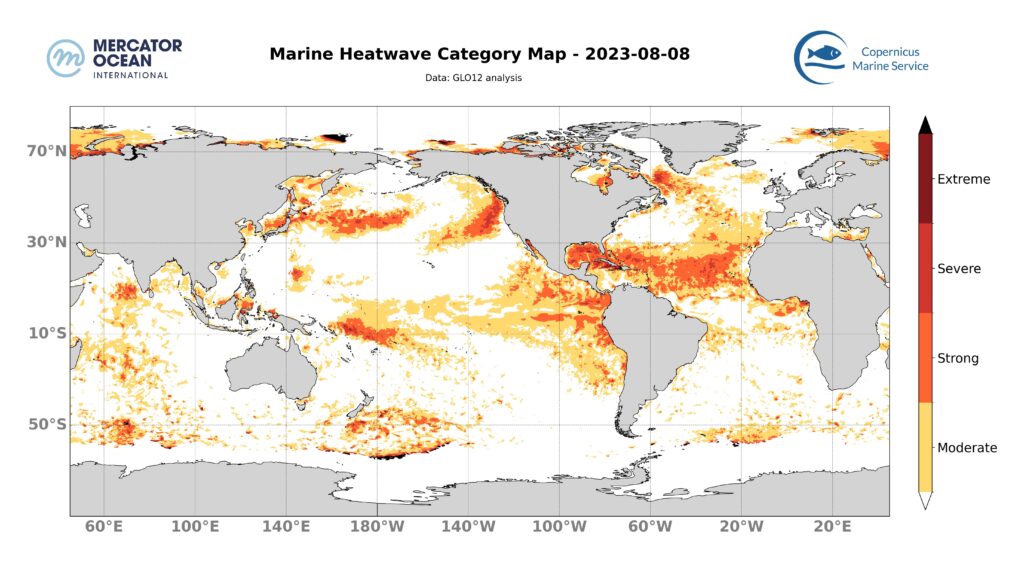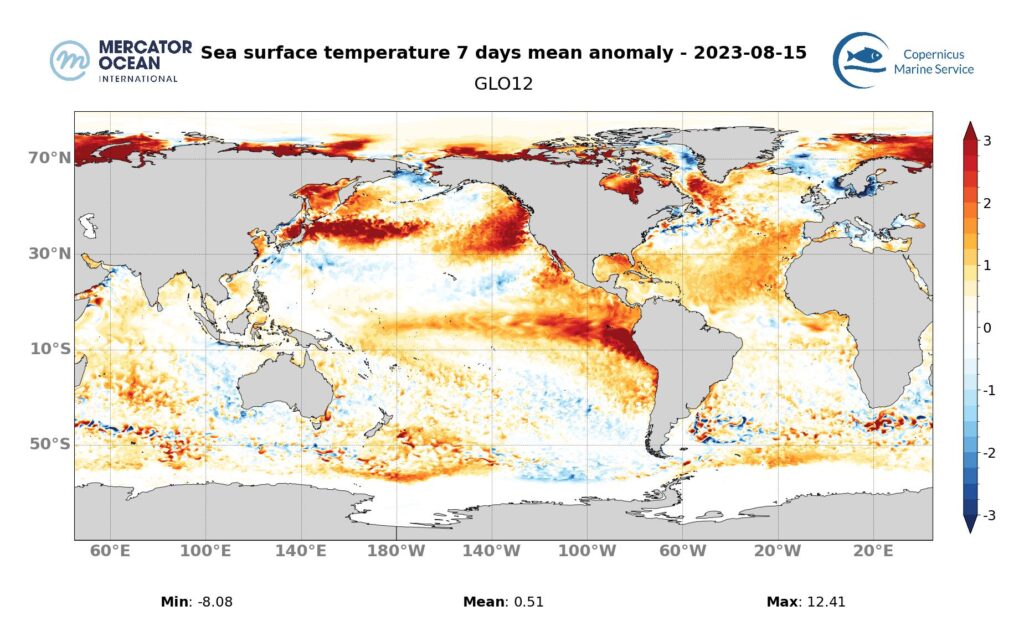Mercator Ocean International oceanographers examine marine heatwaves across the global ocean for the first week of August and forecasts for the second week of August 2023. They analyse a variety of datasets from observation analyses (satellite sea surface temperature maps) to model analyses (assimilating satellite and in situ observations) and model forecasts.¹


Assessment for 8 August 2023
- In Europe :
o The heat wave in the Mediterranean basin continues to diminish, confined to the south-east of the basin and becoming moderate.
o A moderate MHW is also present to the west of the Iberian Peninsula.
- Global :
o The tropical Pacific is still in a moderate to strong heat wave condition reaching high intensity near the coast of Peru, which is consistent with current El Niño conditions.
o Marine heat waves in the North Pacific are still present in strong conditions, particularly off Japan and near the north-west coast of the United States. A positive surface temperature anomaly of 2 to 3°C has been observed.
o The Labrador Sea and the Eurasian coast also have a strong MHW and a positive surface temperature anomaly of 2 to 3°C.
o The MHW in the tropical Atlantic is still present.
o The Tropical Pacific, Tropical Atlantic and North Pacific areas concerned have accumulated more than 30 days of extreme temperatures, with the exception of the area north of Japan, which has accumulated around 20 days of extreme temperatures.
Forecasts for 15 August 2023
- In Europe :
o For August 15, Mercator Ocean International predicts the disappearance of the marine heat wave in the eastern Mediterranean and a slight strengthening of the marine heat wave around the Iberian Peninsula (which corresponds to the atmospheric heat wave currently observed over Spain and Portugal).
o Weekly temperature anomalies are around +1°C around the Iberian Peninsula. - Global :
o For August 15, forecasts show a fairly stationary situation with the marine heatwaves observed the previous week remaining unchanged: North Atlantic (Labrador Sea), Tropical Atlantic and Eastern Tropical Pacific.
o Weekly temperature anomalies are in the order of +2 to +3°C, +1°C, +2 to +3°C for the North Atlantic (Labrador Sea), Tropical Atlantic and Eastern Tropical Pacific zones respectively.
What are marine heatwaves?
Marine heatwaves (MHW) are extreme rises in ocean temperature for an extended period of time. They can occur at different locations in the ocean, and their magnitude and frequency have increased over the last couple of decades, with harmful impacts on ecosystems, and human activities. According to the latest report released by the Intergovernmental Panel on Climate Change (IPCC AR6 SYR), it is found with high confidence that in the near-term at 1.5°C global warming, the increasing frequency of marine heatwaves will increase risks of biodiversity loss in the oceans, including from mass mortality events.2
How are marine heatwaves calculated?
A marine heatwave is a heat episode during which the temperature is significantly higher than a certain threshold for at least 5 consecutive days.

The seasonally-varying threshold is defined on a daily basis according to a sufficiently long climatic period (in this case 1993-2016). So, for a given place and a given day, knowing all the surface temperatures observed over the last 30 years, a heatwave situation is defined as one where the temperature measured is within 10% of the maximum values observed (i.e. above the 90th quantile, see diagram), for at least 5 consecutive days.
The main characteristics of heatwaves are their duration and intensity. The intensity for a given day corresponds to the value in degrees above the 90th quantile (blue arrow), which can either be calculated as the cumulative intensity throughout the heatwave event, or the maximum intensity.
Heatwaves are categorised on the basis of their deviation from the mean temperature or anomaly (green arrow): a deviation of more than 2 times the difference between the 90th quantile and the mean corresponds to a heatwave in the strong category; a deviation of more than 3 times corresponds to a heatwave in the severe category; and a deviation of more than 4 times corresponds to a heatwave in the extreme category.
¹Analysis of datasets: OSTIA sea surface temperature observations analysis (Copernicus Marine Service), OISST sea surface temperature observations analysis (NOAA), GLO12 model (Copernicus Marine Service, Mercator Ocean International)
² IPCC AR6 SYR 4.3 https://www.ipcc.ch/report/ar6/syr/downloads/report/IPCC_AR6_SYR_LongerReport.pdf
